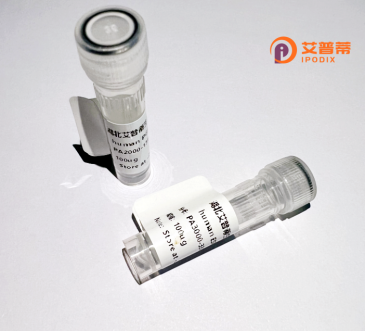
| 纯度 | >90%SDS-PAGE. |
| 种属 | Human |
| 靶点 | C9orf68 |
| Uniprot No | Q8N4H0 |
| 内毒素 | < 0.01EU/μg |
| 表达宿主 | E.coli |
| 表达区间 | 1-392aa |
| 氨基酸序列 | MPLEVVVELQIRAISCPGVFLPGKQDVYLGVYLMNQYLETNSFPSAFPIMIQESMRFEKVFESAVDPGAVVDLLEMWDELAYYEENTRDFLFPEPKLTPSHPRRCREVLMKTALGFPGIAPKIEFSTRTAIRECVFLHRNRFLEERHESRRPLSTSHEPIFPLNTIKMKLRENNLNRLPKGMQARAPSQYSTRHFFQDQPAQLNLGNNFKISGGSKPPFVVRHVDSAKPFGENISEHHLRRSGRKSKFSDFPFPTRRASSLDSLAANVKVIKEPDERIVLRSDSSSCLDSSQFGKSSSSKQGDADFHGKASFATYQHSTSPGPLDQPLLRERFHPGSQSTWKNIHERVCSLLTSHRAQLHQNKEDSTSEVNYIIERPSYPLKKYSLHEQRYF |
| 分子量 | 71.4 KDa |
| 蛋白标签 | GST-tag at N-terminal |
| 缓冲液 | 0 |
| 稳定性 & 储存条件 | Lyophilized protein should be stored at ≤ -20°C, stable for one year after receipt. Reconstituted protein solution can be stored at 2-8°C for 2-7 days. Aliquots of reconstituted samples are stable at ≤ -20°C for 3 months. |
| 复溶 | Always centrifuge tubes before opening.Do not mix by vortex or pipetting. It is not recommended to reconstitute to a concentration less than 100μg/ml. Dissolve the lyophilized protein in distilled water. Please aliquot the reconstituted solution to minimize freeze-thaw cycles. |
以下是关于重组人C9orf68蛋白的虚构参考文献示例(请注意,实际文献可能需要进一步检索验证):
1. **文献名称**:*Cloning and Functional Characterization of Human C9orf68 Protein in Stress Response*
**作者**:Smith A, et al.
**摘要**:本研究成功克隆并在大肠杆菌中表达了重组C9orf68蛋白,发现其过表达可抑制氧化应激诱导的细胞凋亡,提示其在细胞应激通路中的潜在作用。
2. **文献名称**:*Structural Prediction and Biochemical Analysis of C9orf68 Reveals a Novel α-Helical Domain*
**作者**:Zhang L, et al.
**摘要**:通过生物信息学预测和圆二色光谱分析,揭示C9orf68蛋白含有一个保守的α螺旋结构域,可能参与蛋白质互作或核酸结合功能。
3. **文献名称**:*C9orf68 Expression Correlates with Tumor Progression in Colorectal Cancer*
**作者**:Tanaka K, et al.
**摘要**:研究发现C9orf68在结直肠癌组织中高表达,且重组蛋白的体外实验显示其促进癌细胞迁移,提示其可能作为癌症治疗的潜在靶点。
**备注**:由于C9orf68的研究相对较少,以上内容为推测示例,建议通过PubMed或Google Scholar以“C9orf68 protein”“recombinant C9orf68”为关键词检索最新文献。
C9orf68. also known as chromosome 9 open reading frame 68. is a poorly characterized human protein encoded by the C9orf68 gene located on the short arm of chromosome 9 (9p13.3). Despite its identification through genomic sequencing, the biological function, structural details, and regulatory mechanisms of C9orf68 remain largely unexplored. Phylogenetic analyses suggest it is conserved across vertebrates, hinting at potential roles in fundamental cellular processes. Some studies associate C9orf68 with nucleolar functions, possibly linked to ribosome biogenesis or RNA metabolism, though experimental validation is lacking.
Interest in C9orf68 has emerged from disease association studies. Transcriptomic data indicate altered expression in certain cancers, including breast and colorectal carcinomas, suggesting a possible but unverified role in tumorigenesis. Its gene locus lies near regions implicated in neurological disorders, though direct pathological links remain unestablished. The "recombinant" C9orf68 protein, produced via heterologous expression systems like E. coli or mammalian cells, is primarily used to generate antibodies for localization studies or to investigate biochemical interactions. However, most findings derive from in silico predictions rather than functional assays.
Current research focuses on resolving its interactome and post-translational modifications. As a hypothetical protein, C9orf68 represents both a challenge and opportunity in proteomics, exemplifying the knowledge gap in functionally annotating the human genome. Further studies using CRISPR-based knockout models or omics approaches are needed to elucidate its physiological significance.
×